How to Build a Closet Shelf and Rod
How to Build a Closet Shelf and Rod
OK guys, riddle me this: How tin can my lovely young bride say, "I don't have plenty closet space" and then within hours proclaim, "I don't accept anything to wear"? Whether your clothes equus caballus is a closet hog or you really don't have much closet space, following a few simple guidelines can make a large departure in how to get the nearly out of the closet space you do have.
The chances are pretty skillful that the original rods and shelves in your closets were built with priority given to saving construction fourth dimension and textile. Improving your closet is all about efficient use of space. If the goal is to store as many apparel every bit possible (a worthy goal indeed, according to the wife of my youth), then you need to start with pencil and paper—graph paper works great—and ignore how the closet is now.
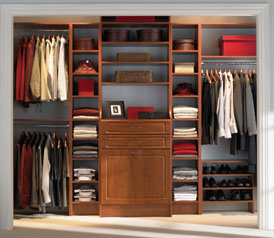
Pencil a Plan
Make a scale sketch of the closet. Measure the horizontal and vertical dimensions of each wall. In a standard non-walk-in cupboard this will exist only the back wall. Divide up this wall infinite into the space that works best for your stuff.
My married woman hangs up about everything so a maximum of closet rod space is ideal for her. I need hanging space for a few collared shirts required to go on certain golf courses, otherwise my stuff wads up and stacks on shelves.
When designing closets, continue in mind that hanging clothes demand 40 inches of vertical space (42 inches for taller people) with the exception of long dresses, overcoats, capes and chest waders—you know what yous take.
At present you can divide up the closet however you want.
Knowing clothes closets should be at least two feet deep helps when planning partitions for walk-in closets. Laying out the closet clockwise, end a section of dress rod at the right cease of the beginning wall, and so, turning 90 degrees to the right, measure 2 feet from the left wall of the next department and starting time with a sectionalisation. This leaves the correct corporeality of room for clothes on the get-go wall to hang without interference.
A basic bedroom cupboard gets a cost-cutting single rod and shelf. For this basic closet, you lot tin can marking a level line on the closet walls at 68 inches and nail 1-by-four cleats along this line. The cleat supports the shelf and provides an anchor point where rod supports can be installed to secure the closet rod. The side cleats (at the ends of the shelf) can run wall to wall in a shallow closet (ii-i/two anxiety or under) but they must extend a minimum of 15-1/2 inches from the back wall to back up a sixteen-inch shelf and provide bankroll for the rod cups.
Only use the shorter version of the cleat if in that location is framing to support the cleat. Otherwise, run the cleat wall to wall.
Pay attention to the header above the door opening when deciding on the depth of the acme shelf. You tin substitute a 12-inch shelf to allow more than room to get items between the shelf and the front end wall of the closet. The side cleats for a 12-inch shelf over a closet rod need to be at least 14 inches long to provide an anchor point for the rod supports.
The same chamber closet can have greatly improved storage area past only adding a partition in the center and making a double rod and shelf on one half. Or, if closet length allows, y'all tin can put in two partitions well-nigh 16 inches apart and install a cavalcade of shelves in the eye, with a unmarried rod and shelf on one side and a double rod and shelf on the other.
Keep in mind how the doors operate. If you have bypass doors, a stack of shelves in the middle may not work also as they would with bi-fold doors, which open out of the way in the center.
Step Back
Ane design principle you'll need to follow is to step back each level to go a reveal where shelves and cleats and partitions come together. The reveal does several things for you. Often shelving has a bull-nosed edge, so you take a radius where the vertical and horizontal pieces come together. By stepping back the supporting fellow member, you can eliminate the gap where the eased edge doesn't touch the straight line of the adjoining piece.
A reveal tin can as well hibernate discrepancies in the walls by requiring less precision where components come up together. Most wood framed walls take some quirks like bowed studs and some are out of foursquare or are not plumb (truthful vertical). In other words, instead of trying to get all of the front edge to come out on the same airplane, you simply accentuate the difference in plane so it looks planned, which, of class, it is.
One quarter inch is a practiced reveal at each level of the cupboard. For instance, if your shelving material is a full xvi inches wide, keep the top shelf at that width and rip the supporting partitions to 15-3/iv inches. Cut down shelves that tie into the partitions to fifteen-ane/ii inches wide. The ends of the supporting cleats for these fifteen-1/two-inch shelves should be 15-1/4 inches from the wall.
Shelves in areas where clothes will not exist hanging tin can exist supported with i-by-2 cleats. Linen or pantry closets, as examples, tin can exist made with 1-past-2 cleats. A dress closet can too contain several shelves that are supported by i-past-2 cleats as long as i-past-4 cleats are used where you want to put a dress rod to support hangers.
Construction Basics
We start by marking the elevation of the shelves. Occasionally yous may need to think through where your layout marks are, then a shelf elevation comes out exactly in line with a window or other feature of the room. But in virtually cases you but need to consider that your layout lines will exist at the bottom of the shelf and the meridian of the cleat. Mark a level line on the wall at the elevations of your horizontal layout marks.
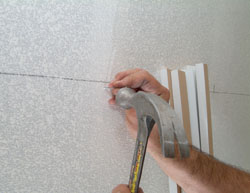
Yous tin can find the studs by searching with a hammer and nail below the layout line. The guys on our crew get very fast at hearing and feeling a stud with the caput of a hammer and and then verifying the location with a blast. Nosotros observe the heart of the stud past hitting the framing twice most 1 inch apart then mark between the locations where you hit the stud. Because you are searching in an area where the cleat will embrace the nail holes, you don't have to worry most damage to the wall.
After finding one stud, we tin speedily locate the remaining studs on the wall by lining up our stud location with one of the stud layout marks on the tape and scratching the wall with the finish of the tape. Shorter wall sections can be marked by using a straight woods scrap and a torpedo level.
Use a level along the back wall as a straight edge when checking the shelf location for square. A straight edge that is longer than the blade of the framing foursquare helps give a better representation of the wall line.
We marking vertical lines for partitions past marking both sides of the partitioning location. If the sectionalization textile is 3/four-inch thick and then the vertical lines volition be parallel lines at 3/4 inch autonomously.
Blast the back cleats into position at the layout lines. A nail angled slightly into the corner usually catches framing.
Measure along the top of the cleat to determine the shelf length at the rear wall. And so, measure, mark and cutting the first shelf in a linen closet layout. After testing the first shelf in the closet you tin can apply information technology as a design to marking the remaining shelves in the aforementioned stack.
We ripped the top shelf of our linen closet from 16 inches down to 12 inches so items tin exist fit between the shelf edge and the door header.
Tip the shelves into position. The painter wanted to salvage some time past having u.s. build the closets packs before painting, just unpainted texture is very soft so be careful non to scrape the walls.
Annotation that the top shelf in a linen closet is shallower and then items can articulate the door header while loading and unloading the shelf.
We utilize an extra vertical cleat where the rod brackets go. Brackets or partitions should exist about 4 feet apart to support the load of items on both the shelf and the rod. Brackets should exist located on studs. A stop clamped to the miter saw tabular array is a good way to cut multiple cleats of the same size without measuring and marking each one.
A router with a round-over chip gives a finished look to the exposed finish of a cleat. Annotation: If you're working with a partner, whoever does the layout writes the cleat dimensions on the wall at the cleat locations. This fashion the other worker tin can brand a cut list without asking additional questions about the layout.
Utilize carpenters glue to give strength to cleats that are attached to partitions.
Tip shelves at an angle and keep the back edge parallel to the wall while installing.
"50" Connection
Walk-in closets often have shelves that join together at ninety degrees in the corner. In fact we often build U-shaped pantry closets with v shelves on three walls, which require 10 of these connections in a unmarried closet.

Because the finished edge of the shelving is balderdash-nosed, it doesn't connect well with another shelf butting into the leading edge. To keep a apartment plane at the joint, we rip off the portion of the bull nose that lines upward with the connecting shelf. This joint is reinforced with biscuits and mucilage to create a continuous shelf wrapping around the corner.

To make an "L" connection with balderdash-nosed fabric, measure out the width of the apartment office of the shelf to where the bull nose starts. Set the table saw to rip off the bull-nose portion of the shelf edge.

Cut off the bull nose simply short of the width of the next shelf. Exist careful because the curve of the saw bract volition make the cutting longer on the lesser than on the acme. Finish the table saw cut with a jigsaw or handsaw.

Employ a beige jointer to cut two slots in the new edge you made with the table saw.
With the first shelf in identify, overlap the adjacent shelf and trace along the edge of the first shelf to get a cut line for the second shelf.
Install biscuits in the slots and utilize wood mucilage to secure at the joint. Tip the 2d shelf into position with biscuit stop downwards first. As the biscuits connection comes together, the other terminate of the shelf can exist maneuvered into position.
Hanging Hardware
Later the painting is done, it'southward time to install the rods and brackets. Measure i of the rod brackets to decide the center of the rod out from the back cleat and down from the shelf. Transfer these measurements to the side cleats and attach the cup centered on this mark.

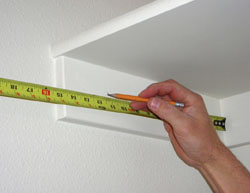
Heart the brackets on the vertical cleat extensions and use a foursquare to make up one's mind the screw hole locations. Attach the bracket with the supplied wood screws.
With the rod cups and brackets in place, measure out and cutting the wall-to-wall rods first. With all of the rods in place, fasten them by pre-drilling the rod through the hole in the bracket and installing the supplied wood screw.
In this walk-in closet the layout was simplified by not putting in a sectionalization at the corner and past leaving the single rod on the left wall at the same level every bit the top rod on the right wall. The completed closet pack has well supported shelves and cupboard rods. The double rod on the correct has a shelf at twoscore inches and 80 inches from the floor.
OK, guys, that's how y'all make more than space for "nada to habiliment."
The Design
You can dissever up a cupboard into virtually anything you can draw on paper, just don't span shelves longer than about 4 feet without support between. I'one thousand redesigning a closet that is 6 anxiety wide past 8 feet loftier. Information technology will accept a double rod and shelf on i side and a stack of shelves on the other.
You lot tin can besides factor in awkwardly shaped and hard-to-shop items such as snowboards and golf clubs. Measure these items and design space for them. I'm factoring in space for a guitar and instance that I don't want to shop in the attic.
How Would You Scribe This?
Shelf-to-wall fits don't accept to be perfect in a painted shelving system because, as my friend Rigo says, "They tin caulk it." Only when a shelf won't go into position and needs to exist trimmed, you might also scribe it at the same time to meliorate the fit.
To close narrow gaps you can use a pencil with the shaft held against the wall, which makes the pencil a gauge that marks the difference betwixt the edge of the pencil and the betoken of the atomic number 82 that touches the surface to be marked.
A ability planer makes short work of trimming the shelf dorsum to the line. Caution: This cut exposes the blades of the planer so if you are not comfy treatment the planer like this, employ a circular saw, grinder or sander.
Shelves Before Pigment
If your shelving projection is in new structure or an addition, y'all can install the shelving after texture merely earlier painting the walls. With the shelves in, all of the wood components can be spackled, caulked and painted right along with the walls.
What Yous'll Need
• 1×2 MDF (or other paintable textile)
• ane×iv MDF
• 16" shelving
• Circular saw
• Biscuit joiner
• Router
• Boom gun
• Squares
• Levels
How to Build a Closet Shelf and Rod
Posted by: forresterhilethim.blogspot.com



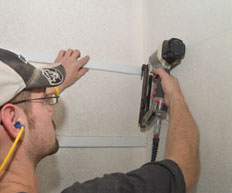
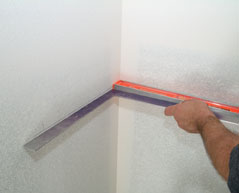

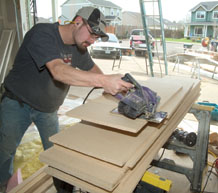
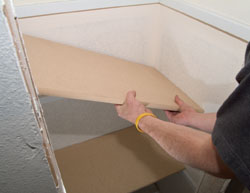

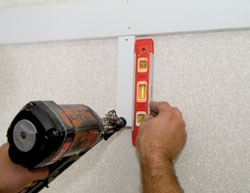
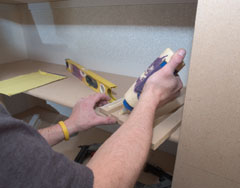

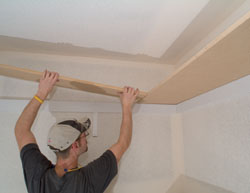
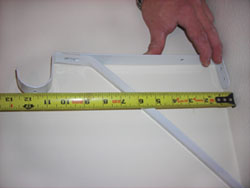

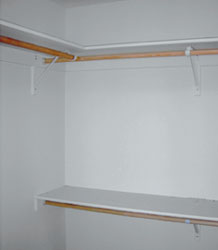
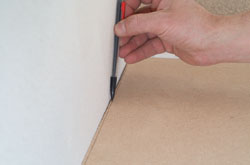
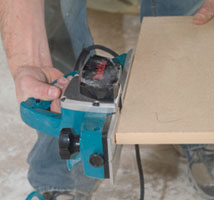
0 Response to "How to Build a Closet Shelf and Rod"
Post a Comment